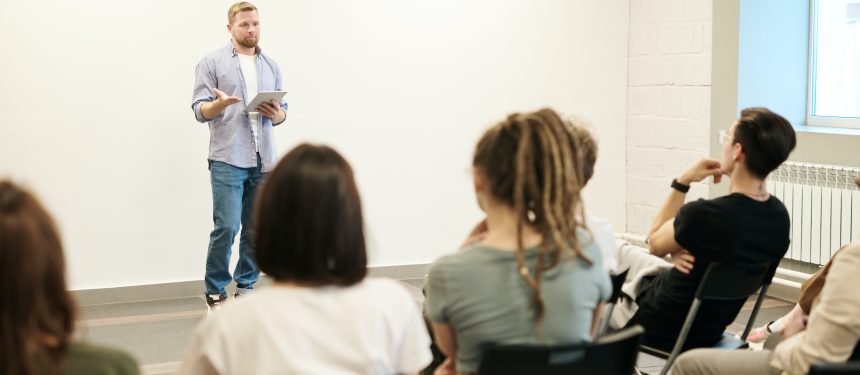As coronavirus turns the traditional university experience upside down, changing the ways we design and deliver teaching, are contact hours still a valuable mark of quality?
News and business analysis for Professionals in International Education
Have some pie!
Re-imagining contact hours – how best to measure the value of education?
 The concept of contact hours is enshrined in many module specifications and course descriptions Photo: Pexels
The concept of contact hours is enshrined in many module specifications and course descriptions Photo: Pexels The concept of contact hours is enshrined in many module specifications and course descriptions, yet the guidance on contact hours that universities use was first published by the QAA as long ago as August 2011. Although it is clear and (historically) useful, this doesn’t reflect the changes over the last nine years in online delivery – or the current Covid-19 landscape.
“Contact time between students and staff forms only one part of an overall approach to learning and teaching”
Specifically, the QAA guidance notes that ‘contact time with staff comes in various different forms, depending on its intended purpose’. Reflecting that some contact time would happen virtually or online, it says: ‘Contact time may also take a virtual rather than face-to-face form, through the use of email, email discussion groups, virtual learning environments and other technology-aided means’.
A measure of quality?
Contact hours are taken by some as a proxy for quality, and thus an indicator of value for money. Some members of university staff are wedded to this approach, embedding the concept into course design and delivery.
However, contact time between students and staff forms only one part of an overall approach to learning and teaching. There is no evidence to suggest that, taken alone, contact hours offer a meaningful way in which to measure quality.
Changing circumstances, changing delivery
We know now that, from September, many universities are planning to provide a hybrid student experience to help protect students from infection and facilitate social distancing. They want students to physically attend university and enjoy an outstanding student experience, but be safe as well.
These plans will generally provide for some physical face-to-face contact in protective ‘bubbles’ or small groups, supported by some online delivery through various learning tools and platforms.
A new approach
Course modules will need to be modified to take this new landscape into account. For example, while translating a one-hour lecture into a one-hour Zoom call may seem an easy way to ensure the contact hours defined in the module are maintained, Zoom calls are not the same as lectures.
Students may ‘attend’ but not necessarily be engaged in the learning process. Some students may not be able to participate at the prescribed time due to other factors.
As a result, many academics are looking at how they can design asynchronous learning activities that take place over an extended period of time. How might they measure contact hours for these kinds of activities?
The guidance from the QAA is clear that such activities would be considered as contact time, but there is a challenge in documenting how much time these activities would take.
Cultural and logistical challenges
Another challenge for many universities is cultural: where contact hours are ingrained into module specifications, doing something differently or introducing an innovative new solution becomes almost impossible to implement, as asynchronous activities are not constrained by time.
There are things that universities can do to enable a cultural shift and ensure that they both maintain the quality standards expected of them and ensure that the students receive an engaging experience.
Six things to think about:
1. By creating a detailed and flexible description of what a university expects and understands by the term ‘contact hours’ in the context of the Covid-19 landscape, both staff and students can clearly understand how it applies to them.
2. Module descriptions may be modified to take hybrid or blended delivery models into account.
3. Presenting a rounded picture of teaching, learning and assessment on a course, including the methods that do and do not involve contact time, can help students understand what the module is going to be like and whether it is right for them.
4. Providing exemplars and models that staff can use to modify their own modules means they don’t need to ‘re-invent the wheel’ individually each time.
5. Building training sessions on designing and delivering asynchronous and other types of online sessions can support academic staff with the necessary experience and skills to design effective and engaging online sessions and activities.
6. Ensuring that appropriate help and support is in place, as well as guidance and training, means that staff who are finding the process of converting their programs challenging can get the support they need, when and where they need it.
“There is no evidence to suggest that, taken alone, contact hours offer a meaningful way in which to measure quality”
A complete overhaul?
Some universities which have been delivering online courses have changed module specifications entirely to omit the notion of contact hours.
In her blog on ‘Zoom fatigue’, Kate Lindsay from UCEM says about contact time: “Essentially, it is perceived as seat-time in a physical location. However, what really defines quality actually has little to do with the space contact takes place in, rather than the ways in which educators and students are present in that space and the opportunities available to learn.”
Lindsay goes on to add: “When we understand the essence of what is important in terms of contact in education, it becomes easier to think about what that may look like in different spaces, whether it is on-ground or online.”
Turning education upside down
Reframing thinking around contact hours is an important part of adapting to the new landscape presented by the coronavirus pandemic.
A major cultural shift and change in expectations are required if universities are to fully embrace the opportunities and affordances that remote and online delivery can provide students, boosting engagement and increasing satisfaction.
Jisc is leading a research program around tech-enabled learning and teaching from 2021/22 and beyond. More information on the project is available here.
 James Clay is Jisc’s head of higher education and student experience, coordinating its overall strategy for HE learning, teaching and student experience. He is also responsible for framing how current and future challenges can be resolved by technological innovation and translating key insights into actionable innovation pipelines. He has worked in the sector since 1993.
James Clay is Jisc’s head of higher education and student experience, coordinating its overall strategy for HE learning, teaching and student experience. He is also responsible for framing how current and future challenges can be resolved by technological innovation and translating key insights into actionable innovation pipelines. He has worked in the sector since 1993.
Still looking? Find by category:


